Semi Olympus
The Semi Olympus (セミ・オリンパス) is a 4.5×6cm folder. It was the first camera made by Takachiho (predecessor of Olympus), released in 1936 or 1937 and succeeded by the Semi Olympus II. Today, the camera is often called "Semi Olympus I", but it seems that this designation was not used at the time it was sold.
Contents
Description
 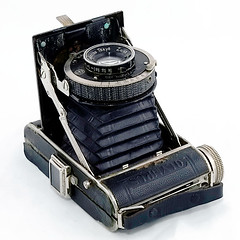
|
| Semi Olympus, Rulex shutter, Zuikô 7.5cm f/4.5 lens no.1098. Picture courtesy of eBayer knight-camera. (Image rights) |
The Semi Olympus is a 4.5×6cm folding camera for 16 exposures on 120 film, with a vertical folding bed and a folding optical finder. The body is a copy of the German Baldax (the large model for #0 shutter size). It was made by the Japanese company Proud, and it is the same as the body of the prewar Semi Proud.[1]
The advance knob is at the bottom right, as seen by the photographer holding the camera horizontally. The film advance is controlled by red windows. The back is hinged to the left and the back latch is covered by a leather handle. The release for the folding bed is to the right of the viewfinder and there is no body release. The name OLYMPUS is embossed in the leather covering at the front.
The lens is a four-element Zuikô 75mm f/4.5, focused by turning the front element. It was the first serial produced camera lens from the future Olympus company. The lens rim is engraved Takatiho Tôkyô Zuikô 1:4.5 f=75mm. No.1xxx,[2] except on one example described below, whose lens is surely not original.
History
Early development
Takachiho started to develop camera lenses in 1934.[3] The design team was led by Dr. Miyata (宮田尚一) and comprised Ing. Yanagawa (future chief researcher for lens design in the 1950s); it was placed under the supervision of Mr Suzuki, chief of the optical department.[4] The first results, tried in mid 1936, included a 105/4.5 and a 75/4.5, both with four elements in three groups.[5] Two lens elements out of four were made of Japanese lens glass, supplied by the Osaka Industrial Research Institute (大阪工業試験所, Ōsaka Kōgyō Shikensho).[6]
The company tried to sell the lenses alone, but did not succeed.[7] Miyazaki Shizuma (宮崎静馬), founder of Proud-sha, talked to Mr Kura (内蔵), in charge of commercial planning at Takachiho, and suggested making a camera around the Zuiko lens and selling it under the "Olympus" brand, already registered by Takachiho for microscopes.[8] He offered to supply the camera bodies, the same as those of the Semi Proud, and insisted on adopting the prestigious Compur shutter, to make the camera easier to sell.[9] According to Sakurai Eiichi, only one lot was made before imported shutters became unavailable;[10] he does not state the reason for this, although it might have been a consequence of the outbreak of war with China in Summer 1937.
Original documents
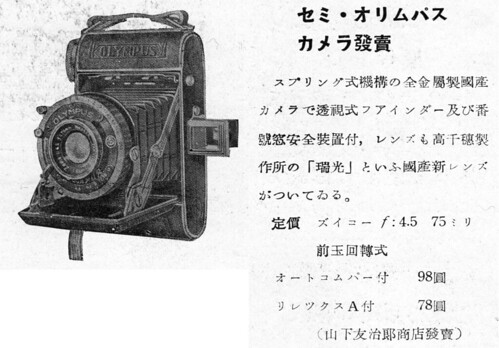
|
| Announcement of the Semi Olympus in Camera Club March 1937. (Image rights) |
The Semi Olympus was featured in the news column of the March 1937 issue of Camera Club, reproduced above.[11] This is the oldest mention of the model reported in Japanese photography magazines.[12] (See however the discussion below for another document dated January 1937, mentioning Takachiho entering camera production.) The column is titled "Release of the Semi Olympus camera",[13] and says that the camera was distributed by Yamashita Yūjirō Shōten. It mentions the Zuiko f/4.5 lens and a choice of two shutters: the Auto Compur, at ¥98, and the Rulex A, at ¥78. (Some sources say that the camera was priced at ¥105, but no original document has yet been found to confirm this.)[14]
The camera was advertised in the June 1937 issue of Asahi Camera, reproduced below,[15] and perhaps in the July 1937 issue of Ars Camera.[16] The advertisement in Asahi Camera was placed by the distributor Yamashita Yūjirō Shōten, not by Takachiho. (In the same issue of the magazine, Takachiho placed a full-page advertisement for the Olympus Standard.) The document mentions the same two versions, with the Rulex A (1–200, T, B) or Auto-Compur, and says that "there is a choice of shutters, between the highest-grade products of imported and domestic production".[17] The prices are unchanged, and the case is listed for extra ¥5. The camera's dimensions are given as 13×7.5×4cm, and the weight as 540g.

|
| Advertisement for the Semi Olympus in Asahi Camera June 1937. (Image rights) |
A brochure was also printed for the Semi Olympus.[18] One of the pictures reportedly shows the serial number 1028 on the Zuiko lens.[19] It is very likely that the serial number sequence began at 1001, a common practice among Japanese manufacturers of the time.
Surviving examples with Compur or Rulex
With Compur shutter
The version with Compur shutter is normally recognized as the earliest, and corresponds to the model originally suggested by Miyazaki Shizuma. At least three surviving examples are known, with lens no.1048, 1124 and 1142.[20]
The Compur shutter gives T, B, 1–250 speeds, and has a self-timer and a thread to attach a cable release. Its front plate has the FD logo on the right (for Friedrich Deckel), the usual COMPUR marking directly engraved at the bottom and a small plate marked OLYMPUS attached at the top. The OLYMPUS nameplate is screwed above the F.Deckel–München name directly engraved on the front plate,[21] a practice which was adopted by other camera makers at the time.[22]
The aperture scale is screwed to the bottom. It goes from 4.5 to 22 in the current progression (4.5, 5.6, 8, 11, 16, 22), at least on the camera with lens no.1142.
There is a release arm in front of the shutter plate, linked to the Compur's own release lever, and tripped by the photographer's right hand. The Compur was designed for a body release, and without this linkage the position of the release lever would have been impractical because of the folding struts. The exact same linkage is found on some examples of the Semi Proud with Compur shutter,[23] and no other camera is currently known with this configuration. This suggests that the Compur shutters were supplied by Proud-sha, which fitted the release arm in its own factory.
  
|
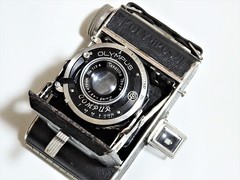 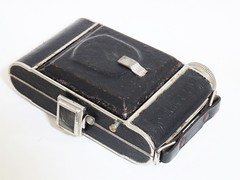 
|
| Takachiho Seisakusho, Semi Olympus-I, Zuiko f4.5/7.5cm lens, Compur shutter Images by yalluflex. (Image rights) |
With Rulex shutter
  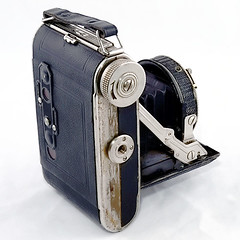
|
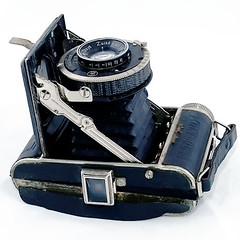  
|
| Semi Olympus, Rulex shutter, Zuikô 7.5cm f/4.5 lens no.1098. Pictures courtesy of eBayer knight-camera. (Image rights) |

|
| Rulex shutter, Zuikô 7.5cm f/4.5 lens no.1098. The white filling is missing from the first digit of the lens number. Picture courtesy of eBayer knight-camera. (Image rights) |
The version with Rulex shutter, mentioned by the original documents, does not appear in the Western reference books or in the company's historical accounts. Two surviving examples have recently surfaced (both pictured in this page), with lens no.1098 and 1137.
The Rulex gives 1–200, B, T speeds,[24] and has a thread for a cable release but no self-timer. The release lever is quite long and comes in front of the speed setting ring. The shutter plate is of the early type (see the Rulex page). The Rulex name is directly engraved at the bottom, and there is an OLYMPUS nameplate screwed to the top — this plate is the same as on the version with Compur. On the camera with lens no.1098, the nameplate appears to cover the Neumann & Heilemann name directly engraved on the shutter face, whose first letter appears on the side. This is probably the case with the other camera too, but the available pictures are less explicit.
The screws attaching the nameplate on both cameras are probably not original: those on the earliest camera (lens no.1098) are cruciform and cannot date from the period, and those on the other example (lens no.1137) look too thick.[25] The simplest explanation is that the cameras were replaced with inappropriate screws. However this has been interpreted as evidence that the two cameras were tinkered with and that their shutters were perhaps not original. Despite the amount of converging evidence found so far, the existence of an official version with Rulex shutter is occasionally denied, and no complete consensus has been reached yet.[26]
The aperture scale, screwed to the bottom of the Rulex shutter, differs from that of the camera with Compur shutter and lens no.1142. On the camera with lens no.1098, the scale goes from 4.5 to 18, in the older progression (4.5, 6.3, 9, 12, 18). The shape and position of the numerals looks the same as on some examples of the Semi Proud, and this might hint that the Rulex shutters were supplied by Proud too. On the camera with lens no.1137, the scale has an intermediate design: the progression is the newer one from 4.5 to 22 but the design of the numerals is closer to the previous camera than to the camera with Compur. These variations on minor parts are extremely common on Japanese cameras of the time, which did not have the degree of standardization attained at a later period.

|
| Rulex shutter, Zuikô 7.5cm f/4.5 lens no.1137. Picture courtesy of Henk. (Image rights) |

|
| Semi Olympus, Rulex shutter, Zuikô 7.5cm f/4.5 lens no.1137. Picture courtesy of Henk. (Image rights) |
Recent replica
A replica of the Semi Olympus I with Rulex has been exhibited by the Korean branch of the company at the 2009 Photo & Imaging camera show in Seoul.[27] The camera was displayed as a genuine example, but the few available pictures clearly show that the camera is a fake, perhaps made from scratch, including the invented lens number 0812. It looks like the design of the front plate was inspired from the pictures displayed above of the camera with lens no.1137.
Version with Koho shutter
Controversial existence
It is usually said that there is a later version with Koho shutter. It does not appear in any of the original documents known so far, but many sources, based on historical accounts by the Olympus company, say that it was released in 1937.[28]
The very first leaf shutter produced by Takachiho was called "Laurel" and was announced in October 1937 for the Semi Olympus II. The name "Koho" only appeared in June 1938, after the name was changed for trademark reasons (see the discussion in Semi Olympus II). The year 1937 for the Semi Olympus with Koho shutter is therefore a mistake.[29]
When the shutter was renamed Koho in mid 1938, the production of the Semi Olympus II was already engaged. It is unlikely that the Semi Olympus I continued to be offered after that date on a regular basis. (This model was essentially a stopgap produced until the company was ready to manufacture its own camera bodies.) It is however possible that some remaining Semi Olympus I bodies received a Koho shutter after 1938, perhaps to clear the inventory.
Early occurrences
The oldest known document showing a photograph of a Semi Olympus with Koho shutter is an article on the history of Olympus cameras, placed by the company in the August 1960 issue of Shashin Kōgyō.[30] The photograph is small and the actual markings are hardly legible, but it seems that the engraving around the lens is Takatiho Tôkyô Zuikô 1:4.5 f=75mm. No.xxxx, and the lens number is perhaps 1077. It is not known if this photograph was taken at the time the article was written or back in the late 1930s.
In the 1960 article, the picture caption says that the Koho has 1/200 top speed. The Koho was originally released with 1/150 top speed, and the switch to 1/200 top speed occurred in late 1939 or early 1940.[31] If the caption is correct, this would mean that the Koho shutter fitted on that particular Semi Olympus was produced after 1939.
The book by Sakurai dated 1983 shows a retouched copy of the same photograph.[32] It is not known if that retouch was applied in the late 1930s for use in promotional documents, a practice which was common at the time, or at a later period.
Surviving cameras
Two surviving examples of the Semi Olympus currently exist with a Koho shutter. The first camera has lens no.1078,[33] close to the other numbers mentioned above and perhaps consecutive to that pictured in 1960. The Koho shutter fitted on that example gives 1–200, B, T speeds. As said above, this indicates that it was fitted on the camera in 1939 at the earliest. The aperture scale attached at the bottom of the shutter plate goes from 3.5 to 22. This is an anomaly, and suggests that the shutter was originally made for another camera with f/3.5 lens and attached to the Semi Olympus as an afterthought, perhaps for repair or for exhibition purpose.
The other camera is held by the Olympus company.[34] It has an early Koho shutter giving 1–150, B, T speeds, produced in 1938 or 1939. Its lens number is 6358, way higher than any of the lenses mounted on the other Semi Olympus I (in the 10xx or 11xx range). Lens numbers observed on the Semi Olympus II (made from 1937 to 1940) range from 1221 to 6257, and those on the Olympus Six (released in 1940) start at 7157.[35] This indicates that the lens currently fitted on the camera was produced around 1939 or 1940.
It seems likely that this camera with lens no.6358 was assembled from spare parts at a relatively late period, certainly for exhibition purpose, as suggested by Awano Mikio.[36] It notably appears that the leather covering of the front part was recreated during the restoration. The letters forming the OLYMPUS name are printed in hollow, whereas the original marking visible on other examples of the Semi Olympus I is in relief. It is likely that the shape of the marking was misinterpreted by the restorers, who certainly had no other Semi Olympus I at hand and were working from pictures.
Production estimate
It seems that the serial numbers for the Zuiko f/4.5 lens started at 1000 or 1001, and that no serial number was assigned to the body by Takachiho. The highest lens number known on a Semi Olympus I is 1142 (except for the anomalous no.6358). The earliest known Semi Olympus II has body no.1063 and lens no.1221.[37] On the plausible assumption that the sales of the Semi Olympus I stopped when the model II became available, a subtraction of the two numbers might indicate that only 150 or 160 examples of the Semi Olympus I were made.[38] This estimate should be dealed with care because the lenses were not fit to the camera bodies in strictly ascending order.
In any case, circulated figures of 1,000 Semi Olympus I with Compur shutter are widely overvalued.[39] The picture in Asahi Camera May 1938 showing lens no.1446 or 1448 on a Semi Olympus II indicates that a grand total of less than 500 Olympus cameras were completed at the time (see Semi Olympus II for a more detailed discussion).[40]
Controversy on the release date
Testimonies
Many recent sources, including the company's own historical accounts, say that the Semi Olympus was first sold in 1936 (sometimes specifying September).[41] This date is mentioned in testimonies written various years after the facts, but it is not confirmed in any of the original documents. Its exact significance is unknown: it might point to the completion of the first camera rather than the actual release to the public.
The earliest and most influential testimony is that of Sakurai Eiichi (桜井栄一), who entered the company in 1935 and later became the chief camera designer. In an article dated 1958, he stated that the Semi Olympus was released in 1936 with a Compur shutter, and later received a Koho.[42] This was part of an early attempt at telling the history of Olympus cameras, after the company's archives were destroyed in air raids in 1945.[43] The same story has been repeated since, with the official support of the company, and it seems that all the following mentions of the Semi Olympus being released in 1936 essentially rely on this testimony.
In a much later interview dated 1992,[44] Sakurai describes a sequence of events which took place between the final lens tests in Summer 1936[45] and the release of the camera — attempts to sell the Zuiko lenses alone, contacts with Proud, procurement of shutters and contacts with a distributor — but he does not state if these took a matter of days or months, and he does not specifically mention a release date.
The only other first-hand testimony on the Semi Olympus I is an article dated 2005 by Matsuzaki Sōichirō (松崎惣一郎), Sakurai's brother-in-law.[46] The author remembers that he was shown an example of the camera around 1936, but he is not very specific on the date either.[47]
Earliest document mentioning Olympus cameras
The earliest written source on Olympus camera production found so far is an article in Nihon Shashin Kōgyō Tsūshin dated January 1937, indirectly known from a compilation of past headlines published in a commemorative issue of the magazine.[48] The summary says that "the company Takachiho Seisakusho (today Olympus) that released lenses under the Zuikō name in the previous autumn is increasing its equity by 1 million yen and is entering full-scale [or genuine] camera production."[49] It is unclear if the lenses "released in the previous autumn" correspond to the first attempt at selling the lenses alone or to their fitting on the Semi Olympus. It is equally unclear if the text is about "full-scale production" of the Semi Olympus I or to "genuine production" of camera bodies, corresponding to the experimental Olympus Standard. (Camera production by Takachiho was further mentioned in the same magazine in June 1937, coinciding with the first advertisements for the Olympus Standard.)[50]
Because of the very low production figures, the Semi Olympus I may have remained unmentioned by photography magazines for a few months. The first mention of the camera, in the March 1937 issue of Camera Club, occurred in a relatively minor magazine; it was never featured in the new products columns of mainstream magazines such as Asahi Camera or Ars Camera, and its appearance in advertisements was very brief.[51]
More pictures
  
|
 
|
| Semi Olympus, Rulex shutter, Zuikô 7.5cm f/4.5 lens no.1098. Pictures courtesy of eBayer knight-camera. (Image rights) |
Notes
- ↑ Sakurai Eiichi, pp.64–5 of Kurashikku Kamera Senka no.20; Hagiya, p.14 of the same magazine; Hibi, p.62 of Kurashikku Kamera Senka no.8; and other sources. Francesch, pp.23 and 56–7, says that the body was made by the German company Plaubel, but this is a mistake, certainly originating from a confusion between the company names Proud (written プラウド in katakana script) and Plaubel (written プラウベル).
- ↑ "Takatiho" and "Takachiho" are alternative romanizations of the same name. The pronunciation is closer to the "chi" of "chilly" than to the "ti" of "tinfoil".
- ↑ Date: Sakurai, p.371 of Shashin Kōgyō no.78; Maitani, "Kamera-zukuri he no bōken" (archived); Sakai, p.7 of Kurashikku Kamera Senka no.20; Francesch, p.19.
- ↑ Sakurai Eiichi mentions Dr. Miyata and Ing. Yanagawa on p.371 of Shashin Kōgyō no.78, and Dr. Miyata and Mr Suzuki on p.64 of Kurashikku Kamera Senka no.20.
- ↑ 105/4.5 and 75/4.5: Hagiya, p.13 of Kurashikku Kamera Senka no.20.
- ↑ Hagiya, p.13 of Kurashikku Kamera Senka no.20, about the 75/4.5.
- ↑ Sakurai Eiichi, p.64 of Kurashikku Kamera Senka no.20. He does not specify if the company approached other camera makers or wholesale companies to sell the lenses to the general public, but the former is more likely.
- ↑ Sakurai Eiichi, p.64 of Kurashikku Kamera Senka no.20.
- ↑ Sakurai Eiichi, pp.64–5 of Kurashikku Kamera Senka no.20.
- ↑ Sakurai Eiichi, p.65 of Kurashikku Kamera Senka no.20.
- ↑ Camera Club March 1937, p.58.
- ↑ Kokusan kamera no rekishi, p.335.
- ↑ Original text: セミ・オリンパスカメラ発売.
- ↑ Price of ¥105: Sakurai Eiichi, p.65 of Kurashikku Kamera Senka no.20; Hagiya, p.14 of the same magazine. Even the testimony of Sakurai is not completely certain: such a minor detail might have been remembered wrongly.
- ↑ Advertisement in Asahi Camera June 1937, p.A65, reproduced in Kokusan kamera no rekishi, p.62, in Hibi, p.62 of Kurashikku Kamera Senka no.8 and in Hagiya, p.10 of Kurashikku Kamera Senka no.20.
- ↑ Hibi, p.63 of Kurashikku Kamera Senka no.8. Kokusan kamera no rekishi, p.335, does not mention this.
- ↑ Original text: シャッターは舶来国産夫々の最高級品を選んであり.
- ↑ Awano, p.2 of Camera Collectors' News no.209. In the same article, Awano says that the Semi Olympus was offered with either a Compur or a Rulex A shutter, but he does not specify if this information comes from the brochure or from the June 1937 advertisement in Asahi Camera.
- ↑ Awano, p.2 of Camera Collectors' News no.209.
- ↑ Lens no.1048: example pictured in Francesch, p.56, in McKeown, p.747 and in Sugiyama, item 1213. Lens no.1124: See images of mr.Yalluflex at this article. Lens no.1142: example owned by John Foster and pictured in this page of his own website and here at Chromesix.
- ↑ Private communication to Rebollo_fr by J. Foster, owner of the Semi Olympus with lens no.1142, who dismantled the nameplate to observe what is found underneath.
- ↑ Compur shutters are known to exist e.g. with Kodak, Nagel or Zeiss–Ikon nameplates.
- ↑ Example of the Semi Proud pictured in Hibi, p.62 of Kurashikku Kamera Senka no.8, and example pictured in an advertisement dated February 1938 reproduced in Kokusan kamera no rekishi, p.89.
- ↑ The pictures of the example with lens no.1098 do not show the 1s and 1/2 settings. This is certainly because they are hidden by the release lever; however the possibility that the shutter is actually a Rulex B (5–200, B, T) cannot be entirely discarded.
- ↑ This was pointed out by J. Foster in a private communication to Rebollo_fr.
- ↑ For example J. Foster says the following of the version with Rulex shutter in this page at Biofos: "There is a suggestion based on a mid-1937 advert that Olympus also fitted the Proud body with a Rulex shutter. This may have been the intention for latter batches of Proud bodies, but no authenticated evidence exists that it actually occurred, no mock-up or advert image. [...] I have seen a Rulex version but am not persuaded of its authenticity as its serial number places it in the earliest Compur period, too early to fit any subsequent 1937 theory." This is not the opinion of Awano Mikio, editor-in-chief of Camera Collectors' News, who says on p.1 of Camera Collectors' News no.209 that "the Semi Olympus I was fitting a Zuiko f/4.5 lens in a Compur shutter or a Rulex A shutter by Neumann & Heilemann, on a body made by Proud-sha": セミオリンパスⅠ型がプラウド社製のボディにコンパーシャッター、又はノイマン&ハイレマン製のルレックスAシャッターにズイコー4.5レンズを装置したものであり.
- ↑ News report at Aving Japan.
- ↑ The first mention of this is in the article by Sakurai, p.372 of Shashin Kōgyō no.78, which places the release of the Semi Olympus I with Koho before that of the Semi Olympus II, but does not specify the year. The year 1937 is found in a later work by Sakurai, p.19 of Zuikō yawa (1983), and has been repeated in many other documents.
- ↑ Awano, p.2 of Camera Collectors' News no.209: "It is impossible that the Koho shutter which appeared around mid-1938 was mounted on the model I and sold in 1937." Original quote: 昭和13年中頃から出始めたコーホーシャッターは、Ⅰ型に組み込まれて、昭和12年に発売されたとは信じられません.
- ↑ Picture in "Semi Orinpasu kara Orinpasu Ōto Ai", p.24 of Shashin Kōgyō no.100.
- ↑ The top speed is still mentioned as 1/150 in the advertisement for the Semi Olympus II in Asahi Camera October 1939, reproduced in this page of the Heiki Seikatsu website.
- ↑ Picture in Sakurai, p.19 of Zuikō yawa. The picture is taken from the exact same angle and shows the same features as the picture on p.24 of Shashin Kōgyō no.100. It has obvious traces of retouch, and the print quality is much lower.
- ↑ Example pictured in Hibi, pp.62 and 63 of Kurashikku Kamera Senka no.8; in Orinpasu-ten (cover, pp.3 and 4); and in Omoide no supuringu-kamera-ten, p.23.
- ↑ Example pictured in this page (archived) of the Olympus corporate site, in McKeown, p.747, in Sugiyama, item 1214, in Francesch, p.57, and in many other sources.
- ↑ See Semi Olympus II and Olympus Six.
- ↑ Awano, pp.2–3 of Camera Collectors' News no.209: "I think that the camera was assembled for exhibition purpose from various parts gathered here and there. I wished that the printed media that widely used it as a document exerted more control and restrained from showing this sort of things. These are harsh words, but this is because I was myself seriously bothered by this." Original quote: おそらくは展示のために寄せ集めた材料でまとめ上げられたものと思われますが、資料として広く利用される可能性のある出版物には、そのようなものは発表しないというルールを作って規制して頂きたいものです。憎まれ口をたたきましたが、私も一時は本気で悩まされたうちの一人でしたから。
- ↑ Example pictured in Awano, Camera Collectors' News no.209.
- ↑ This conclusion is naturally reached by Awano, p.2 of Camera Collectors' News no.209.
- ↑ Francesch, p.56, says that "it would seem that only 1,000 units of the Semi Olympus I with Compur shutter were made". This is certainly a guess based on the Semi Olympus II with lens no.2001 pictured on the book cover.
- ↑ Advertisement in Asahi Camera May 1938, p.A52, also reproduced in Hibi, p.62 of Kurashikku Kamera Senka no.8.
- ↑ September 1936: Sakai, p.7 of Kurashikku Kamera Senka no.20 (this source seems extremely accurate on all points). The same date is found in Francesch, p.51.
- ↑ Sakurai, p.372 of Shashin Kōgyō no.78: オートコンパー0番に、ズイコー75ミリF4.5付のセミ判カメラが生れました。これがセミ・オリンパスのⅠ型で、同じ1936年のことです。[...]セミ・オリンパスⅠ型はかくしてコンパー付きからコーホー付にかわったのです。
- ↑ Archives destroyed in air raids: Francesch, p.27.
- ↑ "Zadankai: Orinpasu no michi", pp.64–71 of Kurashikku Kamera Senka no.20.
- ↑ Sakai, p.7 of Kurashikku Kamera Senka no.20, says July 1936 for the final lens tests, and Francesch, p.20, says June.
- ↑ Matsuzaki, p.28 of Kurashikku Kamera Senka no.76.
- ↑ Matsuzaki says that Sakurai got married with his sister in 1936, and showed him a Semi Olympus I around that time: 昭和11(1936)年、私が商業学校2年生の時に姉に結婚話が持ち上がり、話はとんとん拍子に進んで結婚することになったが、その婿さんがオリンパスの桜井栄一氏であった。[...]この時に桜井氏が持ってきて、「こんなカメラを私の会社から出すんだ」と見せてくれたのがセミオリンパス第1号だった。
- ↑ Gyōkai san-jū-nen no ashiato, pp.12–33 of Nihon Shashin Kōgyō Tsūshin July 20, 1967, reproduced on pp.230–51 of Hyaku-gō goto jūkai no kiroku.
- ↑ Gyōkai san-jū-nen no ashiato (January 1937), p.12 of Nihon Shashin Kōgyō Tsūshin July 20, 1967, reproduced on p.230 of Hyaku-gō goto jūkai no kiroku: 昨秋瑞光の名でレンズを発売した高千穂製作所(現在のオリンパス)は資本金を百万円に増資し、本格的カメラ生産に乗り出す. The word honkakuteki (本格的) may mean "genuine" or "full-scale".
- ↑ Gyōkai san-jū-nen no ashiato, p.13 of Nihon Shashin Kōgyō Tsūshin July 20, 1967, reproduced on p.231 of Hyaku-gō goto jūkai no kiroku: "The successful entry of the company Fuji Kōgaku into the camera business has stimulated other lens makers, and Takachiho Seisakusho, Tōkyō Denki (Oriental), Tōkyō Kōgaku, Nippon Kōgaku, Miyoshi Kōgaku and others have all started camera production." (Original text: 富士光学のカメラ業界乗り入れ成功はレンズメーカーを刺激し、高千穂製作所、オリエンタルで東京電気、東京光学、日本光学、ミヨシ光学等一斉にカメラ製作に着手の気配.) The text may contain mistakes: the mention of Nippon Kōgaku as a camera maker at that date is implausible, and Tōkyō Denki is unknown in that context whereas the camera branch of Oriental was called Tōyō Kōki Seizō a few years later.
- ↑ Kokusan kamera no rekishi, p.335.
Bibliography
Original documents
- Asahi Camera June 1937. Advertisement by Yamashita Yūjirō Shōten for the Semi Olympus (I), p.A65.
- Camera Club March 1937. "Sokuhōtō" (速報塔, News column). P.58.
Older historical accounts
- Nihon Shashin Kōgyō Tsūshin July 20, 1967. "Gyōkai san-jū-nen no ashiato" (業界三十年の足跡, Records of thirty years in the business). Pp.12–33. Reproduced in Nihon Shashin Kōgyō Tsūshin (日本写真興業通信). Hyaku-gō goto jūkai no kiroku (百号ごと十回の記録, Ten records, every hundred issues). Tokyo: Nihon Shashin Kōgyō Tsūshin Sha (日本写真興業通信社), 1967. No ISBN number. Pp.230–51.
- Olympus Kōgaku Kōgyō K.K. sales department (オリンパス光学工業㈱営業部). "Semi Orinpasu kara Orinpasu Ōto Ai" (セミオリンパスからオリンパスオートアイ, From the Semi Olympus to the Olympus Auto Eye). In Shashin Kōgyō no.100, August 1960. P.24. (Contains major inaccuracies.)
- Sakurai Eiichi (桜井栄一). "Orinpasu kamera no rekishi" (オリンパスカメラの歴史, "Brief History of Olympus cameras"). In Shashin Kōgyō no.78, October 1958. Pp.371–5.
Recent sources
- Asahi Camera (アサヒカメラ) editorial staff. Shōwa 10–40nen kōkoku ni miru kokusan kamera no rekishi (昭和10–40年広告にみる国産カメラの歴史, Japanese camera history as seen in advertisements, 1935–1965). Tokyo: Asahi Shinbunsha, 1994. ISBN 4-02-330312-7. Item 37.
- Awano Mikio (粟野幹男). "Semi Orinpasu II" (セミオリンパスⅡ, Semi Olympus II). In Camera Collectors' News no.209 (November 1994). Nishinomiya: Camera Collectors News-sha.
- Eimukku 316, Manyuaru Kamera Shirīzu 7 (エイムック316・マニュアルカメラシリーズ7). Orinpasu no subete: Olympus (オリンパスのすべて・Olympus, All of Olympus). Tokyo: Ei Shuppansha, 2001. ISBN 4-87099-428-3. P.8. (Contains a picture of the Semi Olympus with lens no.6358 with a brief caption, and almost nothing else on Olympus cameras prior to the Pen.)
- Francesch, Dominique and Jean-Paul. Histoire de l'appareil photographique Olympus de 1936 à 1983. Paris: Dessain et Tolra, 1985. ISBN 2-249-27679-X. Pp.20–4 and 55–7.
- Hagiya Takeshi (萩谷剛). "Kōkoku kara miru Orinpasu kamera no nagare" (広告から見るオリンパスカメラの流れ, "Olympus camera history seen through the advertisements"). Kamera Rebyū: Kurashikku Kamera Senka (カメラレビュー クラシックカメラ専科) / Camera Review: All about Historical Cameras no. 20, 25 March 1992. No ISBN number. Orinpasu no subete (オリンパスのすべて, special issue on Olympus). Pp.10–1.
- Hagiya Takeshi (萩谷剛). "Orinpasu kamera no subete 1: supuringu kamera <senzen-hen>" (オリンパスカメラのすべて1・スプリングカメラ戦前編, "All of Olympus cameras 1: folding cameras [prewar]"). Kamera Rebyū: Kurashikku Kamera Senka (カメラレビュー クラシックカメラ専科) / Camera Review: All about Historical Cameras no. 20, 25 March 1992. No ISBN number. Orinpasu no subete (オリンパスのすべて, special issue on Olympus). Pp.13–5.
- Hibi Takashi (日比孝). "Nihon no supuringu kamera: Orinpasu" (日本のスプリングカメラ・オリンパス, "Japanese folding cameras: Olympus"). Kamera Rebyū: Kurashikku Kamera Senka (カメラレビュー クラシックカメラ専科) / Camera Review: All about Historical Cameras no.8, September 1986. No ISBN number. Supuringu kamera (スプリングカメラ, special issue on spring cameras). Pp.62–5.
- Lewis, Gordon, ed. The History of the Japanese Camera. Rochester, N.Y.: George Eastman House, International Museum of Photography & Film, 1991. ISBN 0-935398-17-1 (paper), 0-935398-16-3 (hard). P.53 (brief mention only).
- Maitani Yoshihisa (米谷美久). "Kamera-zukuri he no bōken" (カメラ創りへの冒険, "Venturing into camera production"). Volume 1 of Haikei — Sekkeisha yori (拝啓・設計者より, "Dear Sir, from the designer"). Published in the Zuiko Club website, belonging to the Olympus Imaging Corp.
- Matsuzaki Sōichirō (松崎惣一郎). "'Orinpasu kurōmu shikkusu' to sono koto domo" (「オリンパスクロームシックス」とその周辺のことども, "About the 'Olympus Chrome Six'"). Kamera Rebyū: Kurashikku Kamera Senka (カメラレビュー クラシックカメラ専科) / Camera Review: All about Historical Cameras no.76, June 2005. ISBN 4-257-13078-4. Kurashikku kamera katachi to kinō 'supuringu kamera hen' (クラシックカメラ形と機能「スプリングカメラ編」, special issue on spring cameras). Pp.28–31. (The author is Sakurai Eiichi's brother-in-law.)
- McKeown, James M. and Joan C. McKeown's Price Guide to Antique and Classic Cameras, 12th Edition, 2005-2006. USA, Centennial Photo Service, 2004. ISBN 0-931838-40-1 (hardcover). ISBN 0-931838-41-X (softcover). P.747.
- Omoide no supuringu-kamera-ten (思い出のスプリングカメラ展, Exhibition of beloved self-erecting cameras). Tokyo: JCII Camera Museum, 1992. (Exhibition catalogue, no ISBN number.) P.23.
- Orinpasu-ten — oputo-dejitaru-tekunolojī no kiseki (オリンパス展・オプトデジタルテクノロジーの軌跡, Olympus exhibition, the tracks of opto-digital technology). Tokyo: JCII Camera Museum, 2005. (Exhibition catalogue, no ISBN number.)
- Sakai Shūichi (酒井修一). "Orinpasu no rekishi" (オリンパスの歴史, "History of Olympus"). Kamera Rebyū: Kurashikku Kamera Senka (カメラレビュー クラシックカメラ専科) / Camera Review: All about Historical Cameras no. 20, 25 March 1992. No ISBN number. Orinpasu no subete (オリンパスのすべて, special issue on Olympus). Pp.6–9.
- Sakurai Eiichi (桜井栄一). Zuikō yawa (ズイコー夜話, Zuiko stories). Gendai Kamera Shinsho (現代カメラ新書) no.86. Tokyo: Asahi Sonorama, 1983. ISBN 4-257-08086-8.
- Sugiyama, Kōichi (杉山浩一); Naoi, Hiroaki (直井浩明); Bullock, John R. The Collector's Guide to Japanese Cameras. 国産カメラ図鑑 (Kokusan kamera zukan). Tokyo: Asahi Sonorama, 1985. ISBN 4-257-03187-5. Items 1213–4.
- "Zadankai: Orinpasu no michi" (座談会・オリンパスの道, "Conversation: the way of Olympus"). Interview of Sakurai Eiichi (桜井栄一), Maitani Yoshihisa (米谷美久) and Kawazoe Mitsuo (河添光男), by Saeki Kakugorō (佐伯恪五郎). Kamera Rebyū: Kurashikku Kamera Senka (カメラレビュー クラシックカメラ専科) / Camera Review: All about Historical Cameras no. 20, 25 March 1992. No ISBN number. Orinpasu no subete (オリンパスのすべて, special issue on Olympus). Pp.64–71.
Links
In English:
- Medium-format cameras, chronology and wallpapers in the Olympus English official website (archived), showing pictures of the Semi Olympus with lens no.6358
- Olympus folding cameras at John Foster's site
- Chrome Six Website by François Rossi, showing pictures of the Semi Olympus with lens no.1142 and 6358 in the gallery section
- News report at Aving Japan, showing the Korean replica of the Semi Olympus
In Japanese:
- Medium-format cameras (archived) and chronology (archived) in the Olympus Japanese official website
- Semi Olympus and Semi Olympus II in the history pages of the Olympus Photo Club website. (The information there seems to be based on the article by Hibi in Kurashikku Kamera Senka no.8.)
| Olympus Classic Cameras |
|---|
| Semi | Semi II | Six | Chrome Six | Flex | Standard | 35 | Ace | Pen | Pen F | FTL | OM-1/2/3/4 | OM-10/20/30/40 | Trip | µ (mju:) | XA |